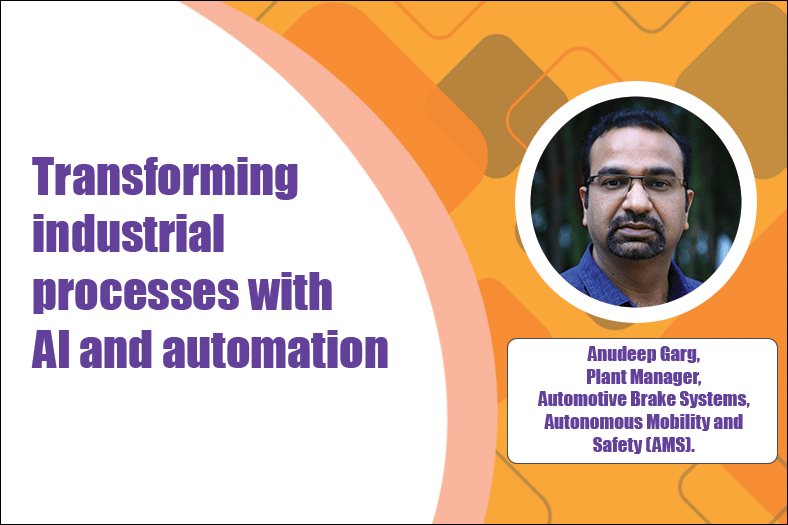Transforming industrial processes with AI and automation
By OEM Update Editorial June 9, 2021 2:41 pm IST
Investments to adopt cutting-edge technologies remains to be a challenge for SME and MSMEs, further restricting them to have efficient manufacturing processes.
Anudeep Garg, Plant Manager –Automotive Brake Systems, Autonomous Mobility and Safety (AMS), Continental Automotive India, in an interview with OEM Update, talks discuss the opportunities, benefits and the challenges in adopting Industry 4.0 and Industry 5.0 technologies.
Industries embracing Industry 4.0 and Industry 5.0
Industry 5.0 is about a closer collaboration between humans and smart machines, or robots. It is a natural progression of Industry 4.0 practices, which was about digitisation and automation of processes. Industry 5.0 is about finding the right balance between automation and humans.
With Industry 5.0, we are looking at a future where robots will do mundane, repetitive tasks while humans handle the creative aspects. With a higher degree of personalisation required in some sectors and products, Industry 5.0 will become necessary. It is not about a matter of adoption, but of growth – where we find the right balance.
Industry 5.0 is essentially a transition where people will work alongside robots, smart and connected machines. In the mix, we will also have a vital role in the Internet of Things (IoT) and big data, this will give us the edge in data analysis.
Indian companies have accelerated their pace of adoption of Industry 4.0 practices due to COVID-19. Some companies like Continental, which have been doing this for a while, will naturally look to further optimise these practices and move towards Industry 5.0. We already deployed COBOTs at some of our plants. We use a mix of automation and manual processes to make things more efficient.
Major areas of transformation and business prospects
With the implementation of Industry 4.0 practices, many of these technologies have been deployed in day-to-day activities. For instance, at Continental, we use Augmented Reality (AR) for remote assistance and problem-solving, AI for facial detection of quality inspectors, Automated Guided Vehicles (AGV) for material movement in the workplace, and COBOTs on the production line.
These processes are deployed both on the front-end and back-end, and have been exceedingly helpful in optimisation. All aspects – right from the supply chain, inventory management, R&D, to the delivery of the end product – have been positively impacted by these technologies.
Bridging the manufacturing technology gap in Indian industries
During times, where social distancing is the norm to abide by, AI technology has provided an integration platform to merge data from various sources, enabling manufacturing companies to generate real-time views for the business and operations remotely.
Challenges in adopting factory automation, AI and robotics for SME and MSMEMSME and SME might initially find it challenging to invest time and technical assistance in adopting new and cutting-edge future technology. Other than the costs of implementing these technologies, the workforce will need to be retrained to use these technologies appropriately.
However, smart factories with modern technologies are going to be cost and time-effective. They will transform the industrial processes and improve efficiency, productivity, costs, value to customers, among other benefits.
This requires planning specific to each industry and company. Automation will be the norm going ahead across various processes and levels. Starting from non-critical functions is advisable since this also gives employees a chance to learn and adapt. Reskilling and training should also be undertaken simultaneously to ensure a smooth transition.
While the benefits are plenty, this change is effort-intensive and capital intense. There is no one-size-fits-all strategy. The scale, pace, and levels of automation are different across organisations.
Future of Indian industries with collaborative robots and human
The manufacturing sector worldwide is slowly getting back to work after a brief slowdown due to the pandemic. In a situation where the risks of the virus still looms large, cobots and robots can help in areas where there is a high density of workers and maintain production line efficiency.
In India, where the manufacturing industry is labour-intensive, cobots help make the process more efficient. Cobots can handle monotonous activities, allowing employees to focus on higher-quality activities.
Continental has deployed Cobots across its plants, which have helped reduce transition times (from approx. 40 to 20 minutes) compared to the manual work, assisting in achieving higher efficiency in our production. Industry 5.0 is a natural transition in manufacturing progression. We have to also bear in mind that wide-scale adoption of Industry 4.0 practices has still not trickled down to grass root level the way it is expected to be, which means a lot of efforts needed here in terms of investment, operational implementation, skilling, and upskilling, etc. Only once we have a platform laid out for connected ecosystem, automation, and digitisation, the transition to Industry 5.0 will be much easier. No doubt Industry 5.0 is the future and we are getting there, we have the right kind of awareness and India will reap immense benefits from Industry 5.0.
Cookie Consent
We use cookies to personalize your experience. By continuing to visit this website you agree to our Terms & Conditions, Privacy Policy and Cookie Policy.
















